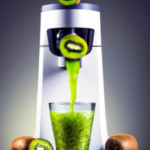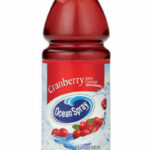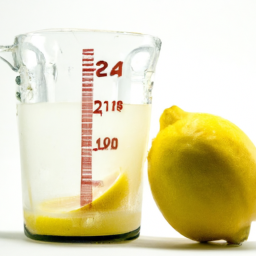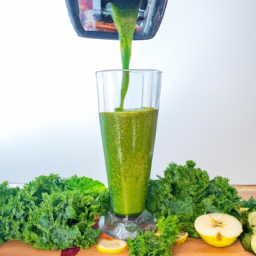I really love starting my day with a refreshing glass of cantaloupe juice. It’s not just the amazing flavor that I enjoy, but also the various health benefits it provides, making it a great addition to any diet plan.
In this article, I’ll walk you through the process of making cantaloupe juice step-by-step, from selecting the perfect cantaloupe to serving and storing the finished product.
Cantaloupe juice is an excellent source of nutrients, including vitamin C, potassium, and beta-carotene. These nutrients are essential for maintaining a healthy immune system, promoting healthy skin, and supporting proper cardiovascular function.
Additionally, cantaloupe is low in calories and high in water content, making it a great option for those looking to maintain a healthy weight or stay hydrated.
So, grab your blender and let’s get started on making some delicious and nutritious cantaloupe juice!
Key Takeaways
- Cantaloupe juice is an excellent source of nutrients, including vitamin C, potassium, and beta-carotene, that can boost your immune system and improve your overall health.
- When choosing and preparing cantaloupe, look for a heavy, round shape with firm skin and no bruises, soft spots, or cracks. Clean it with a vegetable brush under running water and use a sharp chef’s knife and sturdy cutting board to remove seeds and blend it for a smooth and creamy texture. Straining the juice removes unwanted bits and makes it smoother and easier to drink.
- Freshly made cantaloupe juice should be consumed within 24 hours for maximum nutritional value, but it can be stored in the fridge for up to 3-4 days or frozen in an airtight container for up to 6 months. Avoid adding preservatives or additives that can affect its natural freshness and health benefits.
- You can experiment with different flavors of cantaloupe juice by adding ginger, mint, pineapple, or carrot for unique flavor combinations and added nutrients. The decision between using a juicer or blender comes down to personal preference and equipment availability, but a juicer can result in a thinner and clearer liquid, more concentrated in vitamins and minerals.
Benefits of Drinking Cantaloupe Juice
Drinking cantaloupe juice is a great way to boost your immune system and improve your overall health! Cantaloupe is packed with essential vitamins and minerals, including vitamin A, vitamin C, potassium, and fiber.
Vitamin A helps keep your skin healthy, while vitamin C boosts your immune system and helps reduce inflammation. Potassium is essential for maintaining healthy blood pressure, and fiber helps keep your digestive system running smoothly. In addition to its nutritional value, cantaloupe juice is also refreshing and tasty.
However, it’s important to note that like any food or drink, cantaloupe juice can have potential side effects. Some people may experience an allergic reaction to cantaloupe, which can cause symptoms such as hives, swelling, and difficulty breathing. It’s important to talk to your doctor if you have any concerns about consuming cantaloupe juice.
Now that you know about the benefits and potential side effects of drinking cantaloupe juice, let’s talk about choosing the right cantaloupe.
Choosing the Right Cantaloupe
When you’re looking for a sweet and juicy summer fruit to quench your thirst, you can’t go wrong with a perfectly ripe cantaloupe. Picking the right cantaloupe is key to making delicious and nutritious juice.
Look for a cantaloupe that is heavy for its size, with a round shape and a slightly flattened bottom. The skin should be firm with a slight give when pressed. Avoid cantaloupes with bruises, soft spots, or cracks as they indicate overripe or damaged fruit.
In addition to appearance, the flavor profile of a cantaloupe is important. The most flavorful cantaloupes have a sweet, musky aroma and a golden color to their skin. When sliced, the flesh should be bright orange and juicy. A ripe cantaloupe contains high levels of vitamin C, potassium, and beta-carotene, making it an excellent addition to your diet.
With a few simple tips, you can choose the perfect cantaloupe for your juice and enjoy its many health benefits.
Now that you’ve picked the perfect cantaloupe, it’s time to prepare it for juicing.
Preparing the Cantaloupe
First, I wash the cantaloupe under running water and scrub it gently with a vegetable brush to remove any dirt or debris.
Then, I use a sharp knife to cut off both ends of the cantaloupe.
Next, I cut the cantaloupe in half and scoop out the seeds with a spoon.
Cantaloupes are an excellent source of vitamin C, vitamin A, and potassium, and can help improve digestion and boost immunity.
Cleaning and Cutting
Before you begin, make sure to wash the cantaloupe thoroughly and cut it into small pieces for easier blending. To clean the cantaloupe, you can use a vegetable brush to scrub the skin under running water. It’s important to remove any dirt or bacteria that may be on the surface of the fruit.
Once the cantaloupe has been cleaned, you can begin cutting it into small pieces. The best tools for cutting cantaloupe are a sharp chef’s knife and a sturdy cutting board. Start by cutting the cantaloupe in half, then scoop out the seeds with a spoon. Next, cut the flesh into small cubes or slices. Remember to remove any remaining bits of skin or rind.
Cantaloupe is a great source of vitamins A and C, as well as potassium and fiber. Incorporating this fruit into your diet can help boost your immune system and support overall health.
Now that the cantaloupe has been cleaned and cut, it’s time to remove the seeds.
Removing Seeds
To get the most out of your cantaloupe, you’ll want to remove the seeds using a spoon or melon baller. The easiest way to do this is to cut the cantaloupe in half, scoop out the seeds, and then cut the halves into smaller pieces.
If you prefer, you can also use a melon baller to scoop out the seeds. This method is a bit more time-consuming, but it ensures that you get all of the seeds out of the fruit.
When removing the seeds, be sure to scrape the sides of the cantaloupe with the spoon or melon baller to remove any excess pulp. This will help you get the most juice out of your cantaloupe.
It’s also a good idea to rinse the fruit and your tools under running water to ensure that everything is clean before proceeding to the next step of blending the cantaloupe.
If you’re using a spoon to remove the seeds, be sure to use one with a sharp edge to make the process easier and more efficient.
With these tips for easy seed removal and best tools for seed removal, you’re now ready to move on to the next stage of making your cantaloupe juice.
Blending the Cantaloupe
Now, grab your blender and toss in the diced cantaloupe chunks, along with a cup of ice. Start blending the mixture on low speed, gradually increasing to high speed, until the cantaloupe is completely pureed. Here are some blending techniques to keep in mind:
-
Pulse the blender several times to break down larger chunks before blending continuously.
-
Use a tamper or spatula to push the cantaloupe chunks down towards the blades for a smoother consistency.
-
Add other fruits or flavors like mint or lemon to enhance the taste and nutritional benefits.
Blending the cantaloupe is crucial in creating a smooth and creamy texture for the juice. It is also a quick and easy way to incorporate the necessary nutrients into your diet.
Next, we move onto straining the juice to remove any unwanted pulp or seeds.
Straining the Juice
Alright folks, let’s get rid of any unwanted pulp or seeds by straining this delicious blend! Don’t worry if there’s a little bit of texture left, it’ll add some extra flavor to your glass.
To strain the juice, you’ll need a fine mesh strainer or a cheesecloth. Simply place the strainer over a bowl or pitcher and slowly pour the blended cantaloupe into the strainer. Use a spoon or spatula to press down on the pulp and extract as much juice as possible.
If you’re using a cheesecloth, place it over a bowl and pour the blended cantaloupe onto the cheesecloth. Gather the edges of the cheesecloth and twist it tightly to squeeze out the juice.
Straining the juice not only removes any unwanted bits, but it also makes the juice smoother and easier to drink. Plus, it’s a great way to pack in all the vitamins and nutrients that cantaloupes have to offer.
Now that we have our delicious cantaloupe juice, it’s time to pour it up and enjoy! But before we do that, let me share some tips on how to serve and store this refreshing drink.
Serving and Storing Cantaloupe Juice
When it comes to enjoying freshly made cantaloupe juice, it’s important to serve and store it properly to maintain its freshness and nutritional value.
To start, it’s best to consume the juice immediately after making it to ensure the highest quality. However, if you need to store it, place the juice in an airtight container and store it in the refrigerator for up to 24 hours.
When serving cantaloupe juice, it’s best to enjoy it chilled or over ice. You can also add a splash of lemon juice or a sprig of mint to enhance the flavor. Additionally, you can serve it as a base for smoothies or mixed drinks. With these simple serving suggestions, you can enjoy the refreshing taste and health benefits of cantaloupe juice.
Moving on to the next section, there are many variations of cantaloupe juice that you can try to switch up the flavor and add more nutrients to your drink.
Variations of Cantaloupe Juice
Get creative with your cantaloupe drinks by trying out different variations that’ll add more nutrients to your diet and switch up the flavor. Here are some cantaloupe juice recipes with unique flavor combinations that you can try:
- Cantaloupe and Ginger Juice – ginger adds a spicy kick and helps with digestion.
- Cantaloupe and Mint Juice – refreshing and perfect for hot summer days.
- Cantaloupe and Pineapple Juice – the sweetness of pineapple balances the mild flavor of cantaloupe.
- Cantaloupe and Carrot Juice – a healthy combination packed with vitamins A and C.
Cantaloupe is an excellent source of vitamin C, potassium, and beta-carotene, making it a great addition to your daily diet. Drinking cantaloupe juice is a delicious way to reap its nutritional benefits. Experiment with different flavors and see which one you like best!
As you enjoy your cantaloupe juice, it’s important to keep in mind some health tips for drinking it.
Health Tips for Drinking Cantaloupe Juice
So you’re interested in trying out cantaloupe juice for its many health benefits? Great choice! But before diving in, you may be wondering if you can use a juicer instead of a blender to make the juice.
The answer is yes, you can use a juicer, but keep in mind that some of the fiber and nutrients may be lost in the process. Additionally, you may be curious about how long the juice will last.
Generally, freshly made cantaloupe juice should be consumed within 24 hours to ensure maximum nutritional value.
Can I Use a Juicer Instead of a Blender?
If you’re feeling fancy, go ahead and use a juicer instead of a blender for your cantaloupe juice – it’ll give you a smoother finish than a blender could ever dream of.
Although a blender is more commonly used for making smoothies, a juicer can be just as effective with certain fruits and vegetables. When using a juicer, the machine separates the juice from the pulp, resulting in a thinner and clearer liquid. This can be especially helpful if you’re trying to increase your intake of vitamins and minerals, as the juice will be more concentrated.
However, there are some cons to using a juicer. For one, it can be more expensive than a blender. Additionally, some juicers can be difficult to clean and require more prep work, as you’ll need to cut the fruit into smaller pieces. With a blender, you can simply toss everything in and blend it together.
Ultimately, the decision between using a juicer or blender comes down to personal preference and what equipment you have available.
So, now that you know the pros and cons of using a juicer for your cantaloupe juice, the next question is how long will the juice last?
How Long Will the Juice Last?
Wondering how long your freshly squeezed cantaloupe juice will last in the fridge? The shelf life of cantaloupe juice depends on several factors, such as the method of extraction, storage methods, and whether preservatives or additives were used.
Freshly squeezed cantaloupe juice can be stored in the fridge for up to 3-4 days, but the taste and nutritional value will begin to deteriorate after the first day.
To extend the shelf life of cantaloupe juice, you can freeze it in an airtight container for up to 6 months. When thawed, the juice may have a slightly altered taste and texture but will still retain its nutritional value.
Avoid adding any preservatives or additives as they can affect the natural freshness and health benefits of the juice. So, it’s best to consume the juice as soon as possible to reap maximum benefits.
Frequently Asked Questions
Can cantaloupe juice be frozen?
Yes, cantaloupe juice can be frozen. To preserve the flavor, add a squeeze of lemon juice before freezing. Cantaloupe juice is a good source of vitamins A and C, and has been shown to support healthy digestion.
Can I add other fruits to my cantaloupe juice?
Yes, I love mixing fruits in my cantaloupe juice to create unique taste combinations. Some of my favorite additions include strawberries, blueberries, and oranges. Cantaloupe juice is also packed with vitamin C and beta-carotene, which support immunity and skin health.
How long does cantaloupe juice last in the fridge?
I store cantaloupe juice in the fridge for up to 3 days. Its shelf life depends on the freshness of the fruit and how it was prepared. Glass containers are best for storing, and adding lemon juice can help preserve it. Cantaloupe juice is a good source of vitamin C and potassium, and may aid digestion.
Can I use a juicer instead of a blender?
I prefer using a juicer over a blender for making cantaloupe juice. Juicers extract more juice and less pulp. To maximize juice yield, cut the cantaloupe into small pieces and use a low speed setting. Cantaloupe is high in Vitamin C, potassium and fiber, which support immune function and digestion.
Can I use canned or frozen cantaloupe to make juice?
Wow, using canned or frozen cantaloupe to make juice is like trying to make a gourmet meal out of fast food. The nutritional value of fresh cantaloupe juice far surpasses that of canned or frozen. Fresh is always best for health benefits.
Conclusion
In conclusion, making cantaloupe juice is an easy and healthy way to stay hydrated and get the essential nutrients your body needs. Drinking cantaloupe juice can transform your body by providing vital vitamins and minerals, just like how a caterpillar transforms into a beautiful butterfly. It’s rich in antioxidants like vitamin C and beta carotene, which can boost your immune system and protect your cells from damage.
By choosing the right cantaloupe, preparing it properly, and blending it with care, you can have a delicious and refreshing drink that can improve your overall health. Drinking cantaloupe juice regularly can aid digestion, promote healthy skin, and even reduce the risk of cancer.
So, let cantaloupe juice transform your body into a healthier and happier you, just like how a caterpillar goes through a transformation to become a butterfly.
Ilana has been a vegan for over 10 years. She originally made the switch for health reasons, but soon found herself becoming more and more passionate about the ethical and environmental implications of a vegan lifestyle. Ilana is the author of The Graceful Kitchen, a blog all about veganism. She loves to cook up delicious and nutritious vegan meals, and share her recipes with others who are interested in leading a cruelty-free life. Ilana is also a strong advocate for using whole foods as the foundation of a healthy diet, and believes that going vegan is one of the best ways to achieve this.
















